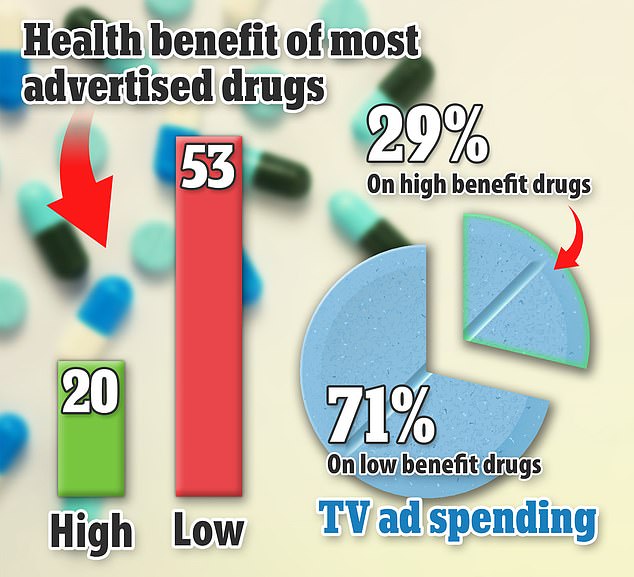Harvard Researchers Analyzed 73 of the Most Publicized TV Drugs in the US, and the Results May Surprise You
>
The Great TV Drug Ad Scam: Less than a third of pills in direct-to-consumer TV ads have high therapeutic value, study finds
- Harvard researchers analyzed 73 of the most advertised drugs in the US in 2015-2021
- Health agencies found that about 53 of them had low therapeutic value.
- A total of 15.9 billion dollars was spent on drug advertising, more than 70% of the total.
<!–
<!–
<!–<!–
<!–
<!–
<!–
Only a fraction of TV medical ads are for drugs that actually improve your health, a study suggests.
Harvard researchers analyzed the most advertised drugs in the US and rated their therapeutic value using ratings from independent health agencies in Canada, France and Germany.
They found that less than a third had “high therapeutic value,” meaning they showed at least a modest improvement in clinical outcomes compared with existing drugs.
They also found that more than twice as much money is spent on drugs that are not very helpful.

Of the 73 most advertised drugs in the US that the researchers analyzed, 53 were found to have low profit, despite receiving more than 70 percent of TV advertising spending between 2015 and 2021. Only 20 of the drugs They were classified as high risk for health. benefit, and received less than 30 percent of the expense
The researchers wrote in the study: “Policymakers and regulators might consider limiting direct-to-consumer advertising to medicines with high therapeutic or public health value or requiring standardized disclosure of comparative efficacy and safety data, but Policy changes would likely require industry cooperation or face a constitutional challenge.’
Direct-to-consumer drug advertising is a booming market, growing nearly fivefold between 1997 and 2016.
In 2020, the pharmaceutical industry spent $4.58 billion on US national television advertising.
Researchers at Brigham and Women’s Hospital at Harvard compiled lists of the most advertised drugs in the US in direct-to-consumer television ads from an industry publication every month between September 2015 and August 2021.
For each drug, they took therapeutic value ratings from independent health technology assessment agencies in Canada, France and Germany.
Each drug was assigned a high or low therapeutic value, based on its added benefit, safety, and strength of evidence, compared with existing drugs.
High therapeutic value was defined as drugs that provide at least a moderate improvement in clinical outcomes compared to existing therapies.
The researchers used the most favorable rating at any time since the drug received approval, which means that the proportion of drugs with the greatest benefit may be overestimated.
Their final list included 73 drugs that had received at least one agency rating of therapeutic value.
The Harvard researchers looked at the proportion of frequently advertised drugs that were rated as having high benefit by any agency and found that only 20 of those were rated as having significant benefit.
They also merged their list with television advertising data from Kantar Media AdSpender and adjusted it for inflation.
The most advertised and money-spending drugs were dulaglutide, for type 2 diabetes, varenicline, for smoking cessation, and tofacitinib, for rheumatoid arthritis.
All three drugs were classified as of low benefit.
A total of $15.9 billion was spent on the 53 drugs classified as of low benefit, compared with $6.4 billion on drugs that health agencies deemed to be of high therapeutic value.
The drugs categorized as high benefit with the most money spent on them were adalimumab, for psoriatic arthritis, sacubitril/valsartan, for heart failure, and pembrolizumab, for lung cancer.
The researchers said drugs with significant therapeutic value are more likely to be noticed and prescribed without advertising, which means manufacturers have more incentive to promote drugs with less value.
The study was published in the journal JAMA Open Network.
